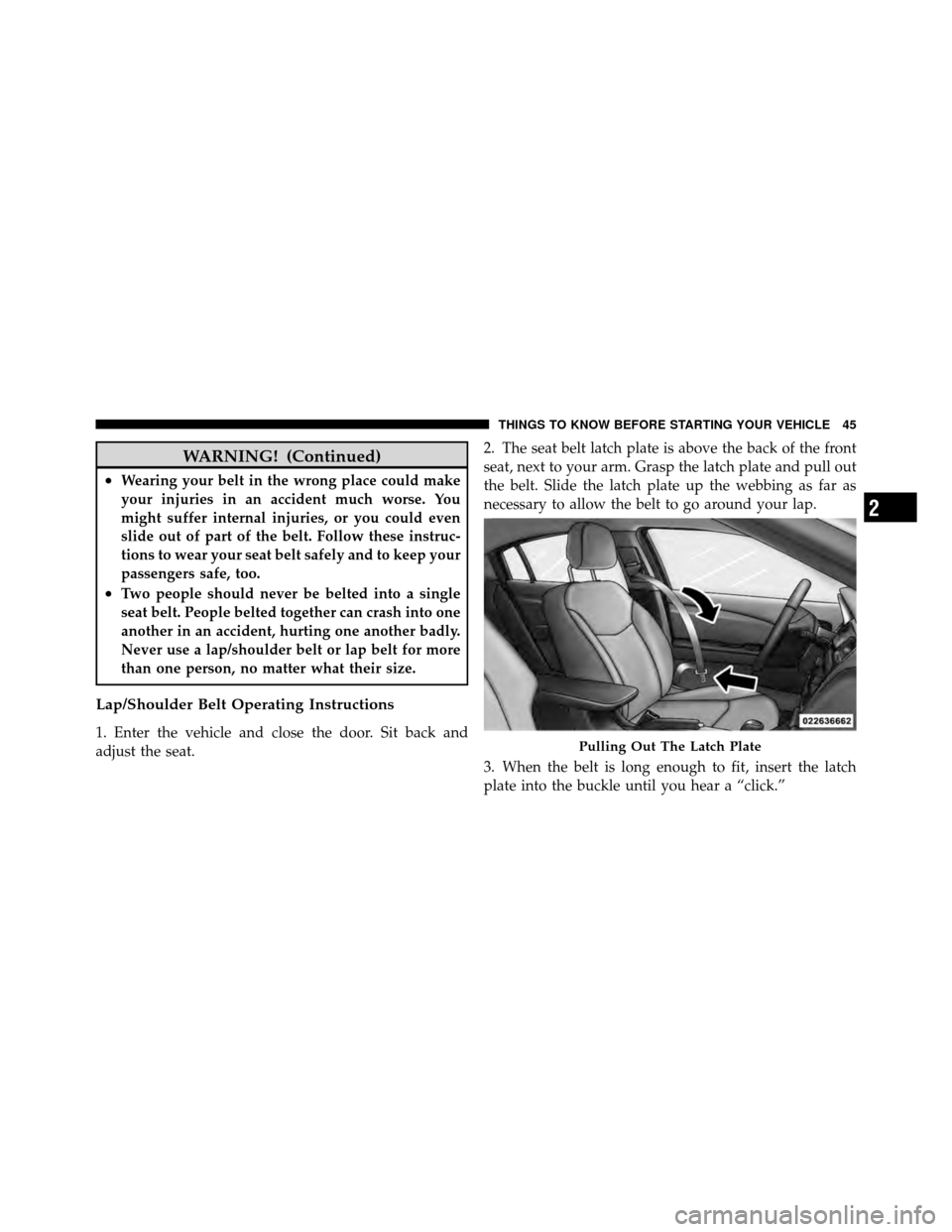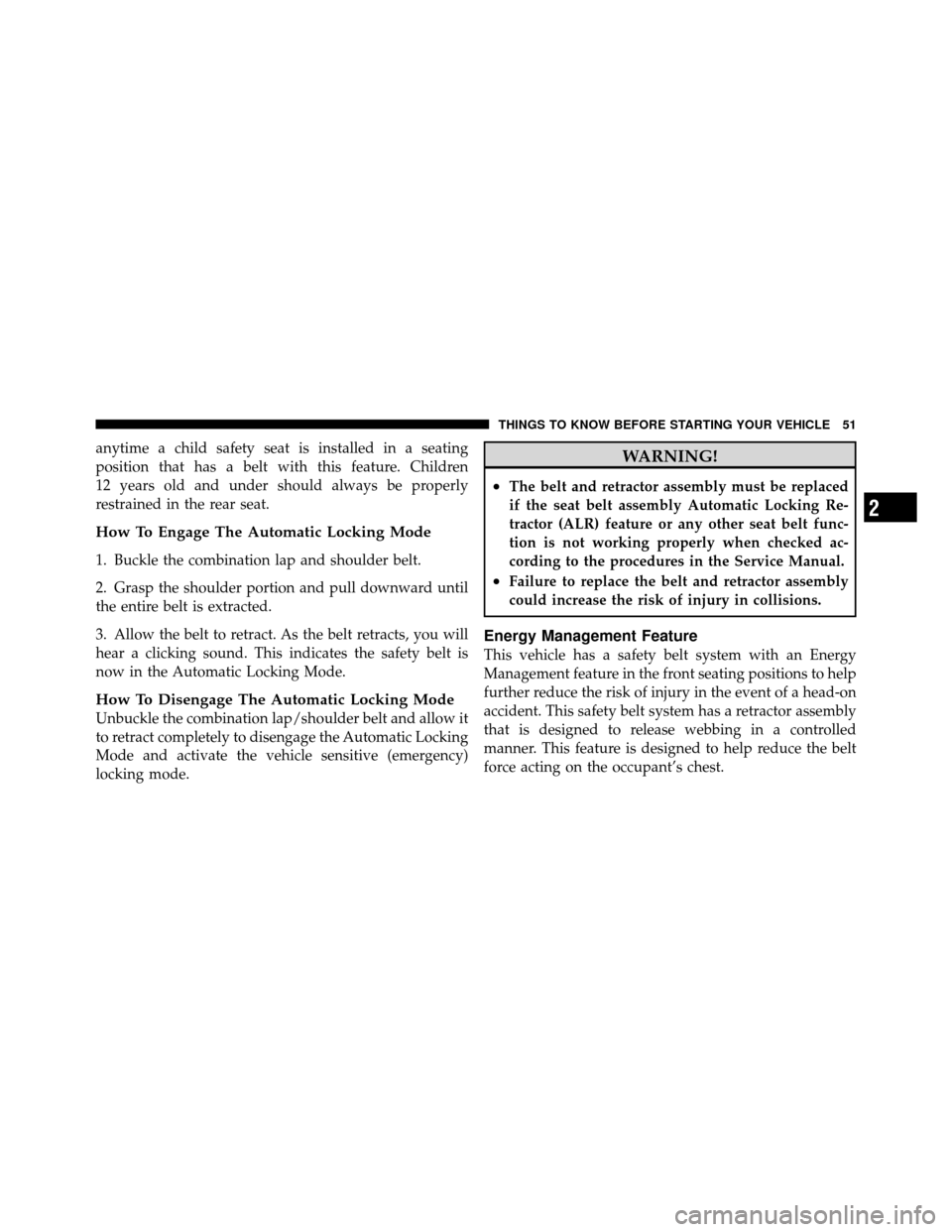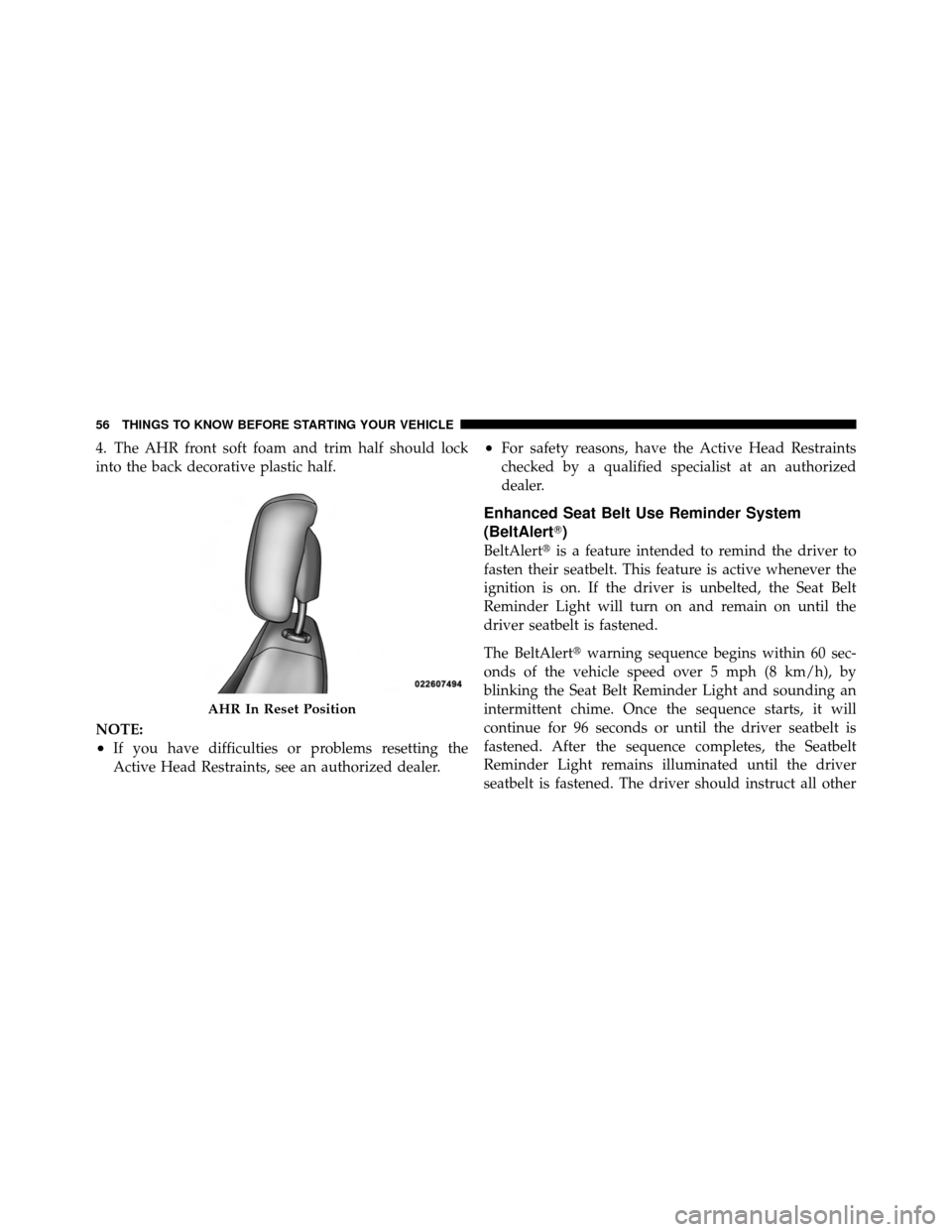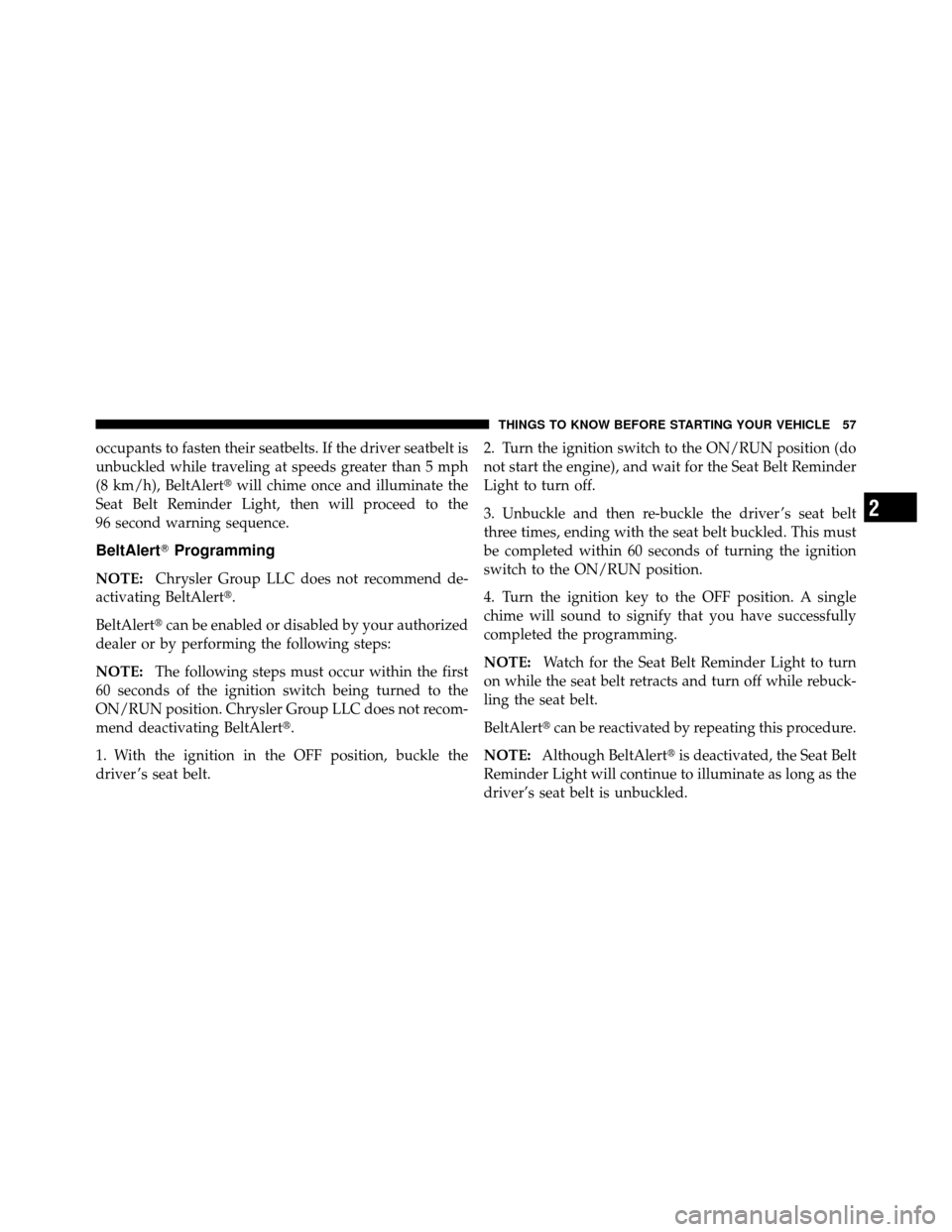Page 46 of 494

Buckle up even though you are an excellent driver, even
on short trips. Someone on the road may be a poor driver
and cause an accident that includes you. This can happen
far away from home or on your own street.
Research has shown that seat belts save lives, and they
can reduce the seriousness of injuries in an accident.
Some of the worst injuries happen when people are
thrown from the vehicle. Seat belts reduce the possibility
of ejection and the risk of injury caused by striking the
inside of the vehicle. Everyone in a motor vehicle should
be belted at all times.
Lap/Shoulder Belts
All seating positions in your vehicle are equipped with
lap/shoulder belts.
The belt webbing retractor will lock only during very
sudden stops or accidents. This feature allows the shoul-
der part of the belt to move freely with you under normalconditions. However, in an accident the belt will lock and
reduce your risk of striking the inside of the vehicle or
being thrown out.
WARNING!
•Be sure everyone in your vehicle is in a seat and
using a seat belt properly.
•It is dangerous to ride in a cargo area, inside or
outside of a vehicle. In an accident, people riding
in these areas are more likely to be seriously
injured or killed.
•Wearing a seat belt incorrectly is dangerous. Seat
belts are designed to go around the large bones of
your body. These are the strongest parts of your
body and can take the forces of an accident the
best.
(Continued)
44 THINGS TO KNOW BEFORE STARTING YOUR VEHICLE
Page 47 of 494

WARNING! (Continued)
•Wearing your belt in the wrong place could make
your injuries in an accident much worse. You
might suffer internal injuries, or you could even
slide out of part of the belt. Follow these instruc-
tions to wear your seat belt safely and to keep your
passengers safe, too.
•Two people should never be belted into a single
seat belt. People belted together can crash into one
another in an accident, hurting one another badly.
Never use a lap/shoulder belt or lap belt for more
than one person, no matter what their size.
Lap/Shoulder Belt Operating Instructions
1. Enter the vehicle and close the door. Sit back and
adjust the seat.2. The seat belt latch plate is above the back of the front
seat, next to your arm. Grasp the latch plate and pull out
the belt. Slide the latch plate up the webbing as far as
necessary to allow the belt to go around your lap.
3. When the belt is long enough to fit, insert the latch
plate into the buckle until you hear a “click.”Pulling Out The Latch Plate
2
THINGS TO KNOW BEFORE STARTING YOUR VEHICLE 45
Page 48 of 494
WARNING!
•A belt that is buckled into the wrong buckle will
not protect you properly. The lap portion could
ride too high on your body, possibly causing
internal injuries. Always buckle your belt into the
buckle nearest you.
•A belt that is too loose will not protect you
properly. In a sudden stop, you could move too far
forward, increasing the possibility of injury. Wear
your seat belt snugly.
Inserting Latch Plate Into Buckle
46 THINGS TO KNOW BEFORE STARTING YOUR VEHICLE
Page 49 of 494
WARNING!
•A belt that is worn under your arm is dangerous.
Your body could strike the inside surfaces of the
vehicle in an accident, increasing head and neck
injury. A belt worn under the arm can cause
internal injuries. Ribs aren’t as strong as shoulder
bones. Wear the belt over your shoulder so that
your strongest bones will take the force in a
collision.
•A shoulder belt placed behind you will not protect
you from injury during an accident. You are more
likely to hit your head in a collision if you do not
wear your shoulder belt. The lap and shoulder belt
are meant to be used together.4. Position the lap belt across your thighs, below your
abdomen. To remove slack in the lap belt portion, pull up
on the shoulder belt. To loosen the lap belt if it is too tight,
tilt the latch plate and pull on the lap belt. A snug belt
reduces the risk of sliding under the belt in an accident.
Positioning The Lap Belt
2
THINGS TO KNOW BEFORE STARTING YOUR VEHICLE 47
Page 50 of 494

WARNING!
•A lap belt worn too high can increase the risk of
internal injury in an accident. The belt forces
won’t be at the strong hip and pelvic bones, but
across your abdomen. Always wear the lap belt as
low as possible and keep it snug.
•A twisted belt will not protect you properly. In a
collision, it could even cut into you. Be sure the
belt is straight. If you can’t straighten a belt in
your vehicle, take it to your authorized dealer
immediately and have it fixed.
5. Position the shoulder belt on your chest so that it is
comfortable and not resting on your neck. The retractor
will withdraw any slack in the belt. 6. To release the belt, push the red button on the buckle.
The belt will automatically retract to its stowed position.
If necessary, slide the latch plate down the webbing to
allow the belt to retract fully.
WARNING!
A frayed or torn belt could rip apart in an accident
and leave you with no protection. Inspect the belt
system periodically, checking for cuts, frays, or loose
parts. Damaged parts must be replaced immediately.
Do not disassemble or modify the system. Seat belt
assemblies must be replaced after an accident if they
have been damaged (i.e., bent retractor, torn web-
bing, etc.).
Lap/Shoulder Belt Untwisting Procedure
Use the following procedure to untwist a twisted lap/
shoulder belt.
48 THINGS TO KNOW BEFORE STARTING YOUR VEHICLE
Page 53 of 494

anytime a child safety seat is installed in a seating
position that has a belt with this feature. Children
12 years old and under should always be properly
restrained in the rear seat.
How To Engage The Automatic Locking Mode
1. Buckle the combination lap and shoulder belt.
2. Grasp the shoulder portion and pull downward until
the entire belt is extracted.
3. Allow the belt to retract. As the belt retracts, you will
hear a clicking sound. This indicates the safety belt is
now in the Automatic Locking Mode.
How To Disengage The Automatic Locking Mode
Unbuckle the combination lap/shoulder belt and allow it
to retract completely to disengage the Automatic Locking
Mode and activate the vehicle sensitive (emergency)
locking mode.
WARNING!
•The belt and retractor assembly must be replaced
if the seat belt assembly Automatic Locking Re-
tractor (ALR) feature or any other seat belt func-
tion is not working properly when checked ac-
cording to the procedures in the Service Manual.
•Failure to replace the belt and retractor assembly
could increase the risk of injury in collisions.
Energy Management Feature
This vehicle has a safety belt system with an Energy
Management feature in the front seating positions to help
further reduce the risk of injury in the event of a head-on
accident. This safety belt system has a retractor assembly
that is designed to release webbing in a controlled
manner. This feature is designed to help reduce the belt
force acting on the occupant’s chest.
2
THINGS TO KNOW BEFORE STARTING YOUR VEHICLE 51
Page 58 of 494

4. The AHR front soft foam and trim half should lock
into the back decorative plastic half.
NOTE:
•If you have difficulties or problems resetting the
Active Head Restraints, see an authorized dealer.
•For safety reasons, have the Active Head Restraints
checked by a qualified specialist at an authorized
dealer.
Enhanced Seat Belt Use Reminder System
(BeltAlert�)
BeltAlert�is a feature intended to remind the driver to
fasten their seatbelt. This feature is active whenever the
ignition is on. If the driver is unbelted, the Seat Belt
Reminder Light will turn on and remain on until the
driver seatbelt is fastened.
The BeltAlert� warning sequence begins within 60 sec-
onds of the vehicle speed over 5 mph (8 km/h), by
blinking the Seat Belt Reminder Light and sounding an
intermittent chime. Once the sequence starts, it will
continue for 96 seconds or until the driver seatbelt is
fastened. After the sequence completes, the Seatbelt
Reminder Light remains illuminated until the driver
seatbelt is fastened. The driver should instruct all other
AHR In Reset Position
56 THINGS TO KNOW BEFORE STARTING YOUR VEHICLE
Page 59 of 494

occupants to fasten their seatbelts. If the driver seatbelt is
unbuckled while traveling at speeds greater than 5 mph
(8 km/h), BeltAlert�will chime once and illuminate the
Seat Belt Reminder Light, then will proceed to the
96 second warning sequence.
BeltAlert� Programming
NOTE:Chrysler Group LLC does not recommend de-
activating BeltAlert�.
BeltAlert� can be enabled or disabled by your authorized
dealer or by performing the following steps:
NOTE: The following steps must occur within the first
60 seconds of the ignition switch being turned to the
ON/RUN position. Chrysler Group LLC does not recom-
mend deactivating BeltAlert�.
1. With the ignition in the OFF position, buckle the
driver ’s seat belt. 2. Turn the ignition switch to the ON/RUN position (do
not start the engine), and wait for the Seat Belt Reminder
Light to turn off.
3. Unbuckle and then re-buckle the driver ’s seat belt
three times, ending with the seat belt buckled. This must
be completed within 60 seconds of turning the ignition
switch to the ON/RUN position.
4. Turn the ignition key to the OFF position. A single
chime will sound to signify that you have successfully
completed the programming.
NOTE:
Watch for the Seat Belt Reminder Light to turn
on while the seat belt retracts and turn off while rebuck-
ling the seat belt.
BeltAlert� can be reactivated by repeating this procedure.
NOTE: Although BeltAlert� is deactivated, the Seat Belt
Reminder Light will continue to illuminate as long as the
driver’s seat belt is unbuckled.
2
THINGS TO KNOW BEFORE STARTING YOUR VEHICLE 57